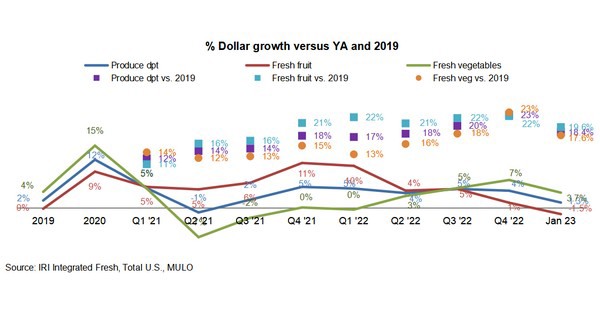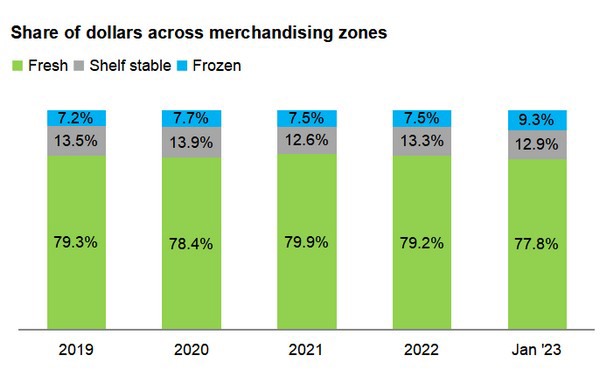“January brought a host of New Year’s resolutions,” said Jonna Parker, team lead, fresh with IRI. “The January IRI survey found that 40 percent of primary shoppers plan to eat healthier, 24 percent aim to get more sleep and 23 percent want to spend more time with friends and family. However, saving more money was the second highest resolution, at 35 percent.” To understand the impact on fresh produce, IRI, 210 Analytics and the International Fresh Produce Association will continue to team up in 2023 with monthly performance reports.
Nine in 10 consumers perceive the cost of groceries and everyday household items to be much (67 percent) or somewhat (22 percent) higher than last year, according to the IRI survey. “Fresh produce is consistently in the top five of examples shoppers cite as having significantly higher prices,” said Joe Watson, IFPA’s VP, retail, foodservice and wholesale.
Inflationary pressure on income is real, with 96 percent being concerned over the high cost of groceries.
 “Special occasions remain a big opportunity for food retail in 2023,” said Parker.
“Special occasions remain a big opportunity for food retail in 2023,” said Parker.
- The January IRI survey found that 55 percent of shoppers planned to watch the Super Bowl, of which only 2 percent were planning to watch it at a bar or restaurant.
- Fifty percent of Americans plan to celebrate Valentine’s Day, with 19 percent planning to cook a special meal at home and 15 percent planning to go out to a restaurant.
Fresh produce prices were also up over 2022, but a relatively low +5.6 percent on a per-pound basis, with low price increases for fresh fruit. Vegetable inflation averaged 5.6 percent in January--also down from the full-year levels.
January 2023 fresh produce sales reached $5.7 billion, up from $5.5 billion in December and an increase of 1.3 percent over January 2022 levels.
In January 2023, the share of fresh fruit and vegetables dropped to 77.8 percent, partly due to below-average inflation. The frozen share increased to 9.3 percent.  Fresh produce represented 77.3 percent of pounds, with 8.2 percent for frozen fruit and vegetables and 14.6 percent for shelf-stable produce.
Fresh produce represented 77.3 percent of pounds, with 8.2 percent for frozen fruit and vegetables and 14.6 percent for shelf-stable produce.
After a strong December, fresh fruit and vegetable performance retreated in January. “Berries are still the powerhouse, but even berries could not hold the line on pounds that were down 4.5 percent,” said Parker. Only four out of the top 10 fruit sellers increased in pounds, being grapes, avocados, mixed fruit and pineapples.
In January 2023, fresh vegetables added $106 million in additional dollars versus January 2022 whereas fruit lost some ground. While a few fruits made it into the top 10 items that gained the most in dollars, the top five placements were vegetables.
The next report, covering February, will be released mid-March. Please contact Joe Watson (jwatson@freshproduce.com) with questions. Click here to read the full report.
 For more information:
For more information:
Anne-Marie Roerink
210 Analytics LLC
Tel: +1 (210) 651-2719
aroerink@210analytics.com
www.210analytics.com
